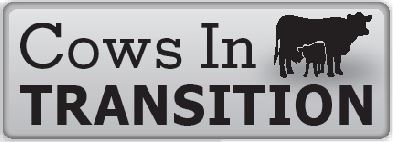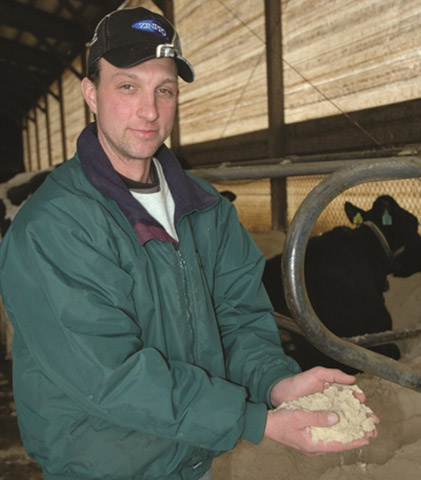Numbers Don’t Lie
This 400-cow herd found an extra $125,000 in income potential
 This is the second of a six-part series on transition cow management. Go to dairytoday.com for the first article, which ran in our January issue. This is the second of a six-part series on transition cow management. Go to dairytoday.com for the first article, which ran in our January issue. |
When your tank average is 90 lb. to 95 lb. per cow per day and your rolling herd average is north of 27,000 lb. per cow, it’s human nature to ignore warning signs that production, cow health and reproduction could be even better. But that’s exactly the position Pam Selz-Pralle and Scott Pralle of Selz-Pralle Dairy, Humbird, Wis., found themselves in for the past five years.
While production was very, very good, the Transition Cow Index (TCI) on their AgSource DHI report told them something was amiss. TCI estimates the financial impact of improving transition cow management and health. (See sidebar)
The numbers were staggering: In both 2011 and 2012, TCI was estimating the 400-cow Selz-Pralle herd was leaving about $125,000 on the table. But given their production levels, Pam and Scott couldn’t believe the numbers were based in reality.
“We had all of our protocols in place for milk quality, feed mixing and reproduction and we had all the details nailed down, so we kind of ignored the TCI numbers,” Pam says.
|
| Learn more |
But there was one thing that nagged at the herd: high somatic cell counts. A few years ago, the herd battled a voltage problem in their freestall facility, which had been built in the 1990s. They were finally able to solve the problem with better electrical grounding.
But the high cell counts persisted. Cell counts were much more than 300,000 cells/ml in summer and dropped to just 225,000 to 250,000 cells/ml in winter. “We were treating up to three clinical cases a week, most of them E. coli with very few responding to tubes and some needing systemic treatment,” says Steve Kahn, the Selz-Pralle herdsman.
Pam called in top mastitis experts to evaluate their cow prep and treatment protocols. Each gave a thumbs up and simply urged them to continue to apply the protocols consistently.
The one issue they had was bedding. Even though they were using sand and bedding weekly, the sand had a high clay content that resulted in tightly packed beds and urine and moisture pooling.
The dairy, which is located in central Wisconsin, is surrounded by sand-fracturing mining operations. The frac-sand is washed and sized, and there is a percentage that cannot be used for mining.
Scott started bedding with the frac-sand refusals in late 2012. The frac-sand is washed and lightly textured—so light it can blow around the barn on windy days.
But the cows love it. “Slowly and surely, our somatic cell counts got better,” Scott says.
Cell counts have since dropped, and now consistently hover between 115,000 and 130,000 cells/ml.
“Now, we treat less than one case of mastitis a week,” Kahn says, “and if we tube a cow, she usually recovers without further treatment.”
 |
Refusals from mining sand operations have proven to be an ideal bedding source, says herdsman Steve Kahn. |
Plus, reproduction has improved. Pregnancy rates were about 17% to 18% prior to the shift to the frac-sand— and they are now at 20%. Pam believes less subclinical mastitis has improved herd immunity and, as a result, conception rates.
She acknowledges the herd also switched to AI 24, electronic activity and rumination monitors that are placed on cows when they calve. Kahn uses the monitors for heat detection but is finding the rumination monitors more valuable.
He watches rumination activity closely the first week after calving and treats any cow that shows reduced rumen activity. These cows bounce back quickly and experience fewer problems moving forward.
The Selz-Pralle team has also moved away from heat synchronization, now breeding mostly on activity. That has had another unintended, but helpful consequence: less bunching of cows at calving.
Now, cows calve throughout the week rather than bunching up on one or two days because they’re now bred when they come into heat naturally. “When we were synchronizing for heat, we were freshening in slugs. We were over-crowded in the fresh pen three to four days a week. That calculates out to 50% of the time,” Pam says.
That, in turn, could have led to dry matter intake fluctuations as cows jockeyed for access to feed. With more even calving, cows now have adequate bunk space every day of the week.
In 2013, Scott convinced his custom corn harvester to fit his chopper with a shredlage attachment.
Shredlage offers increased digestibility through consistent particle length and stalk shredding. Selz-Pralle also replaced hay in the diet with rotary-processed straw which provided a more consistent fiber source. “We see virtually no sorting,” Pam says.
The change paid off quickly. “We saw 3 lb. to 5 lb. more milk. Butterfat went up two points, and it now averages 4.1%. Before, we struggled to maintain a 2.8% protein test, and now, we’re at 3.0%,” Scott adds.
Over the past two years, the daily tank average has been more than 100 lb. per cow. Cows are peaking at 135 lb., with many reaching 170 lb. or more. Displaced abomasums (DA) have dropped by 60%. “Before the shredlage and the straw, we were averaging about one DA per week,” Kahn says. “Last year, we had 20 all year on 480 calvings.”
The Selz-Pralle Dairy team credits all of this to good people and consistency in feeding, milking and protocols. “You have to listen to your cows and to your people,” Pam says. “And you have to respect the data.”
What is the Transition Cow Index?
The Transition Cow Index provides the basis for estimating the economic impacts of improving transition cow management. According to AgSource, the economic impact of TCI is calculated from the following associations:
- Each additional pound of TCI is associated with 1.27 lb. of milk in the current lactation.
- Each additional pound of TCI is associated with a 0.00265% increase in lactation survival rate. In other words, an increase of 1,000 lb. TCI reduces turnover rate by 2.65%.
- Using current prices, a 1,000 lb. change in TCI is worth $250 per cow per year. The spread between TCI scores is about 4,000 lb., meaning there is a $1,000 per cow per year opportunity for improving fresh cow management on many dairies.


 Bonus Content
Bonus Content




